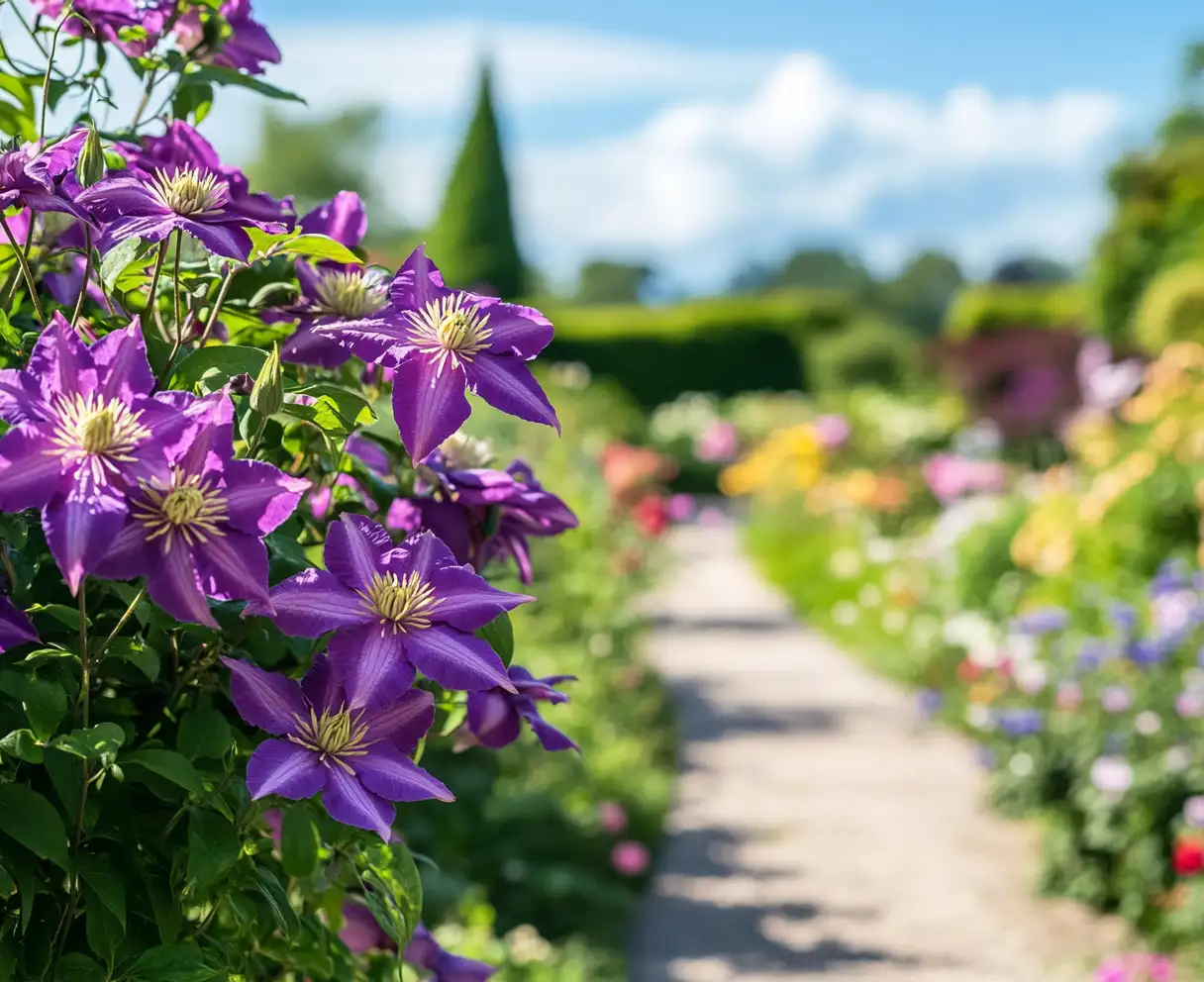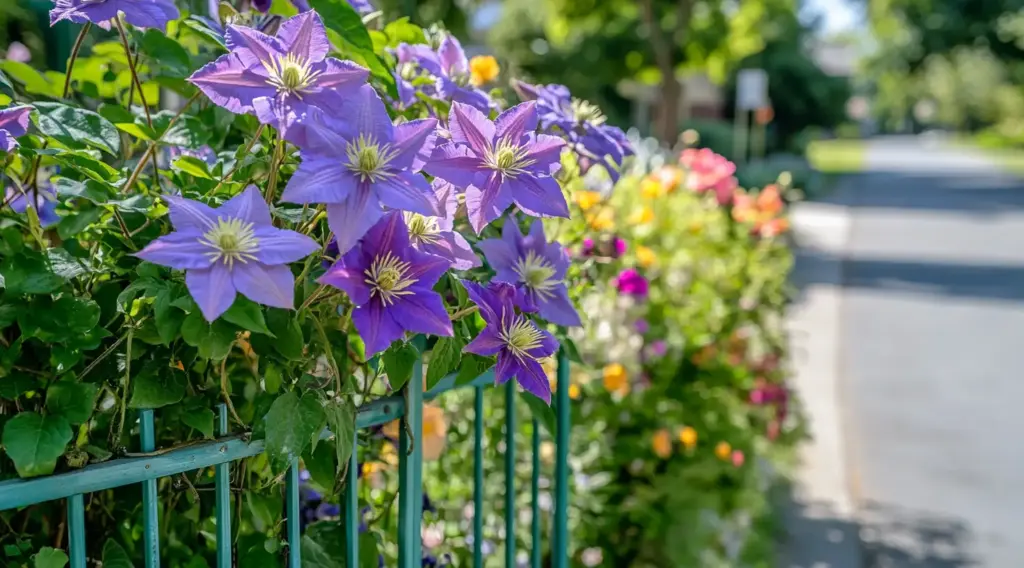Growing clematis vines is one of the most enchanting ways to bring vertical elegance, rich color, and timeless charm into your garden. These hardy perennials bloom with stunning flowers that range from vibrant purples to soft pastels, transforming ordinary fences, trellises, and arbors into living garden art. Whether you’re an experienced gardener or just starting out, clematis vines offer a high-impact look with surprisingly low maintenance. Once established, they reward you year after year with fuller growth and more blooms, making them a dependable favorite for garden lovers. If you’re looking to add structure, texture, and lasting appeal to your outdoor space, growing clematis vines is a beautiful and rewarding choice.
🌿 Love gardening inspiration? Follow me on Pinterest for bold plant ideas, tips, and seasonal color!
Table of Contents
🌿 Important Considerations Before You Buy
Before you get too excited about growing clematis vines, it’s important to understand that not all clematis are created equal. Choosing the right type for your garden’s size, style, and climate can make the difference between a thriving showstopper and a struggling vine.
✔️ Growth Habit: Vigorous vs. Compact
Clematis varieties vary dramatically in growth rate and size. Some are vigorous climbers like ‘Jackmanii’ or ‘Sweet Autumn Clematis’—perfect for covering fences or trellises quickly. Others are more compact, making them ideal for small gardens, containers, or as border fillers. If you’re working with limited space, opt for dwarf or bush-type varieties that offer just as much beauty without overwhelming the area.
✔️ Purpose and Placement
Ask yourself: What do I want this clematis to do?
- Do you want to cover an ugly wall?
- Fill in a bare trellis?
- Add color to a container arrangement?
Answering these questions will help you choose a variety that matches your goals in both size and bloom time.
✔️ Pet Safety
While clematis vines are gorgeous, some varieties are mildly toxic to pets. If you have curious cats or dogs that like to nibble, double-check the variety before planting. Look up toxicity levels in reputable plant databases or consult your vet to stay on the safe side.
🌞 Sunlight Needs
When it comes to growing clematis vines, getting the lighting right is crucial for healthy growth and vibrant blooms. These climbing beauties love the sun—but with a twist.
☀️ Full Sun for Blooms, Shade for Roots
Clematis vines flourish best with at least 6 hours of direct sunlight per day. However, they prefer to keep their roots cool and shaded. Gardeners often follow this golden rule:
“Head in the sun, feet in the shade.”
To keep their roots happy:
- Mulch generously around the base to insulate the soil and retain moisture.
- Plant low-growing companions like hostas, lamb’s ear, or ground covers to create natural shade at the base.
- Use light-colored gravel or stepping stones to reflect heat away from the soil.
🌤 Partial Sun Options
If your garden doesn’t offer full sun all day, don’t worry—many clematis varieties tolerate partial sun (4–6 hours), especially in warmer climates. Just be sure to check the sun requirements on the plant tag or from a reliable nursery before purchasing.
Proper light exposure is one of the most critical factors for successful blooming, so choose your site carefully.
🏗 Choosing & Installing Support
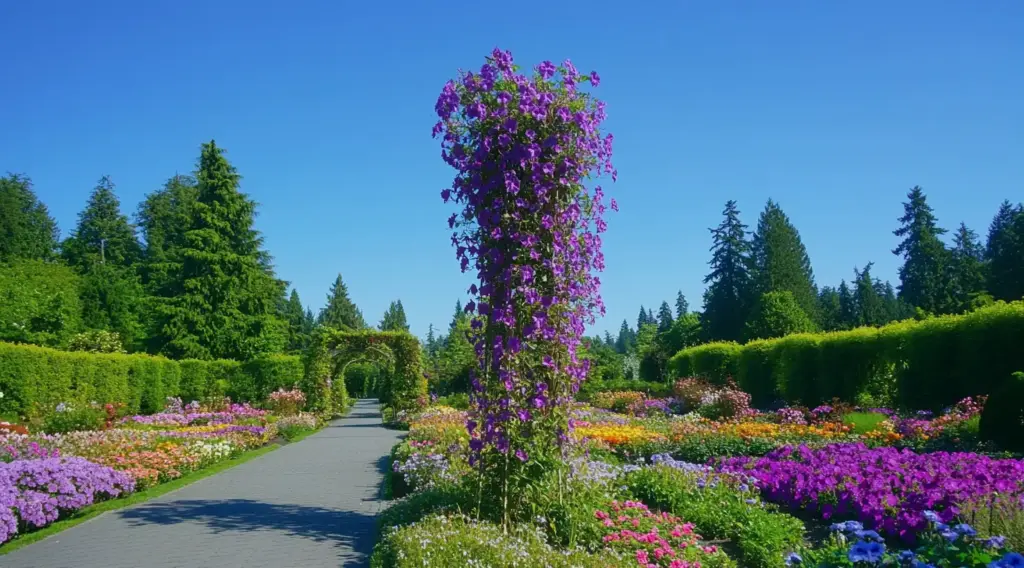
Clematis vines are natural climbers, but how you support them can make a huge difference in both their health and aesthetic appeal. Before planting, always plan how your vine will grow—support first, then soil.
🪜 Install Supports Before You Plant
It’s far easier to put your structure in place before digging holes and disturbing roots. Setting it up in advance prevents root damage and gives your clematis a clear path to follow as it starts to grow.
🧱 Support Options That Work Well:
- Trellises – Lightweight and ideal for walls, containers, or garden borders
- Arbors or arches – Excellent for walkways and garden entrances
- Fences and railings – A practical choice that also provides privacy
- Garden towers or obelisks – Perfect for containers or raised beds
Pro Tip: Choose thin or lattice-style supports. Clematis vines climb by twining their leaf stems around objects, so structures thicker than ½ inch can be hard for them to grip.
🧵 Tie When Necessary
If your clematis variety doesn’t self-cling strongly, loosely tie the young vines to the support with:
- Soft garden twine
- Velcro plant ties
- Stretchable garden tape
Never tie tightly—it can restrict growth and damage the delicate stems.
Proper support encourages strong, healthy growth and helps showcase the blooms in all their glory.
🪴 Using Bush-Type or Compact Clematis
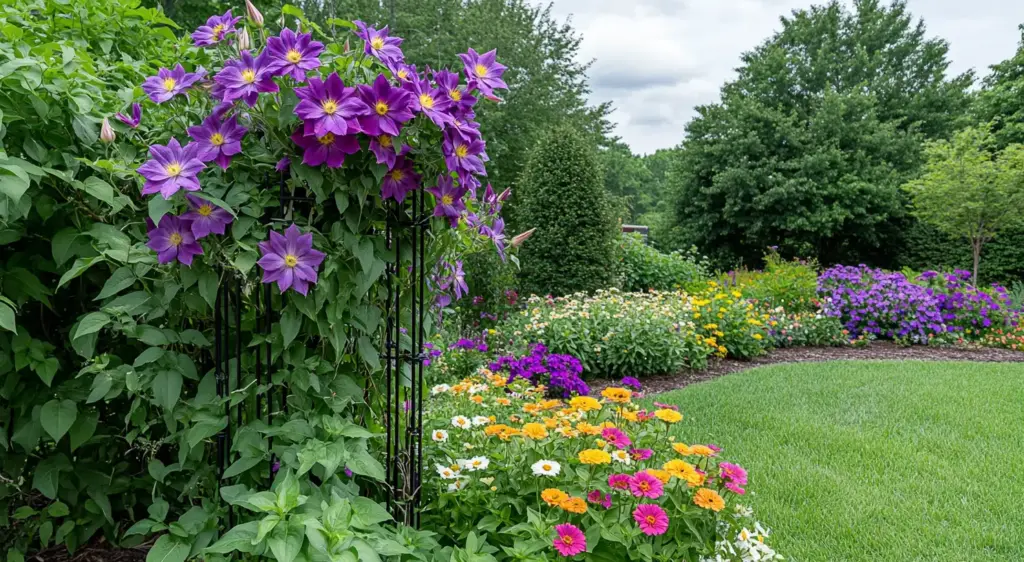
Not every clematis needs to climb. Some varieties stay low, bushy, and beautifully contained—perfect for smaller spaces or gardeners who want vertical color without the vertical hassle.
🌿 Ideal for Containers and Small Gardens
Compact clematis varieties are a fantastic choice if you’re working with:
- Balconies or patios
- Raised beds
- Urban gardens or courtyards
Pair them with a deep pot, high-quality potting mix, and a mini trellis or support ring to help guide early growth. Water consistently, as container-grown clematis can dry out faster.
🌼 Excellent as Garden Fillers
Bush-type clematis work wonderfully along garden bed edges where they can:
- Spill over the borders for a soft, romantic look
- Mingle with other perennials and shrubs
- Provide ground-level color where taller vines may not be practical
Some varieties even offer multiple blooming cycles, giving you bursts of color throughout the season.
Choosing a compact clematis doesn’t mean sacrificing beauty—it simply means fitting lush blooms into smaller or more creative spaces.
🛠️ How to Plant Clematis Vines: Step-by-Step
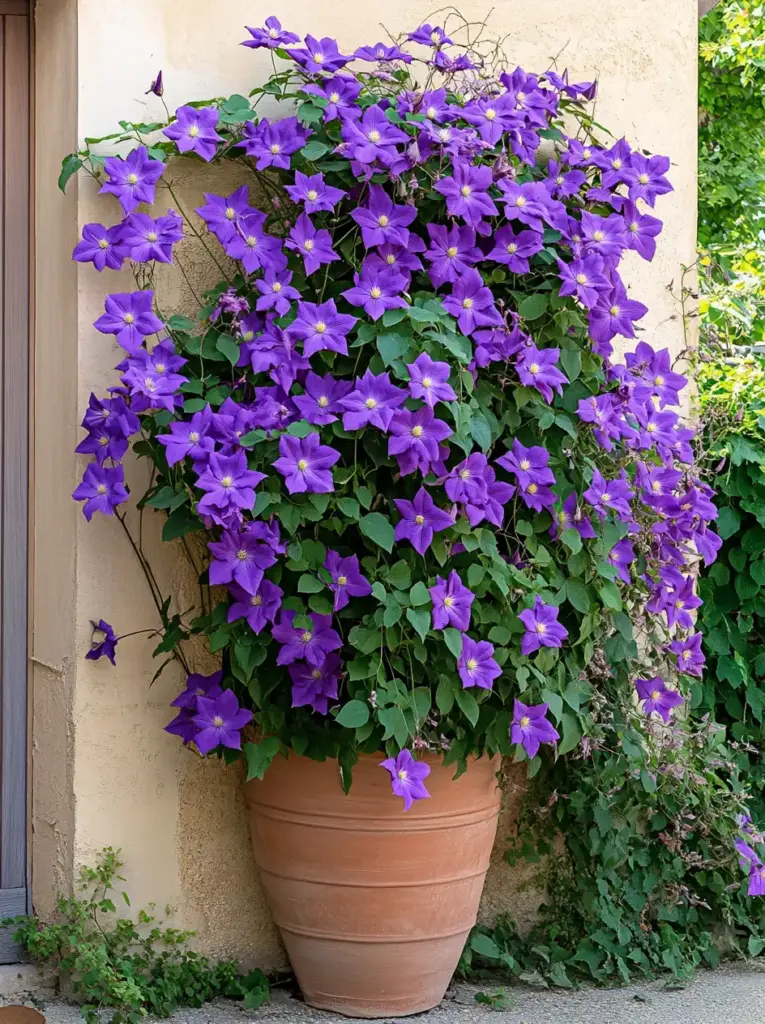
Clematis may be low-maintenance once established, but they’re particular about how they’re planted. A careful start ensures strong roots, fast growth, and long-lasting blooms.
1. Dig a Wide Hole
Start by digging a hole twice as wide and just a bit deeper than the nursery pot. This gives roots room to stretch out and helps prevent compacted soil zones that can stunt growth.
2. Improve the Soil
Mix in compost or aged organic matter to enrich the soil. Clematis vines prefer well-draining, fertile ground—especially important if your native soil is sandy or heavy with clay.
3. Water the Hole (If Dry)
If the soil feels dry, pour water into the hole and let it soak in for 10–15 minutes. This step ensures that the roots won’t hit a dry patch right after planting.
4. Gently Remove the Plant
Tip the pot on its side and carefully slide the plant out, supporting it from the base. Never yank the stem—clematis vines are delicate and can break easily.
5. Loosen the Root Ball
Tease the outer roots gently with your fingers. This encourages them to spread into the surrounding soil rather than circling inside the original pot shape.
6. Set Proper Planting Depth
Place the plant in the hole at the same level as it was in the nursery pot, or slightly deeper if your variety is prone to stem rot. Some gardeners plant 2–3 inches deeper to encourage more stem-root growth.
7. Backfill and Firm the Soil
Use your compost-soil mix to fill the hole. Press gently to eliminate air pockets—but don’t compact the soil too tightly, as this can hinder root expansion.
8. Water Thoroughly
Give your clematis a deep soak right after planting. This helps the soil settle and ensures good root-to-soil contact.
🌱 Optional Tip: Add a light mulch layer or plant a low perennial at the base to shade the roots—following that “feet in the shade” rule.
📐 Structural Tips for Training Clematis
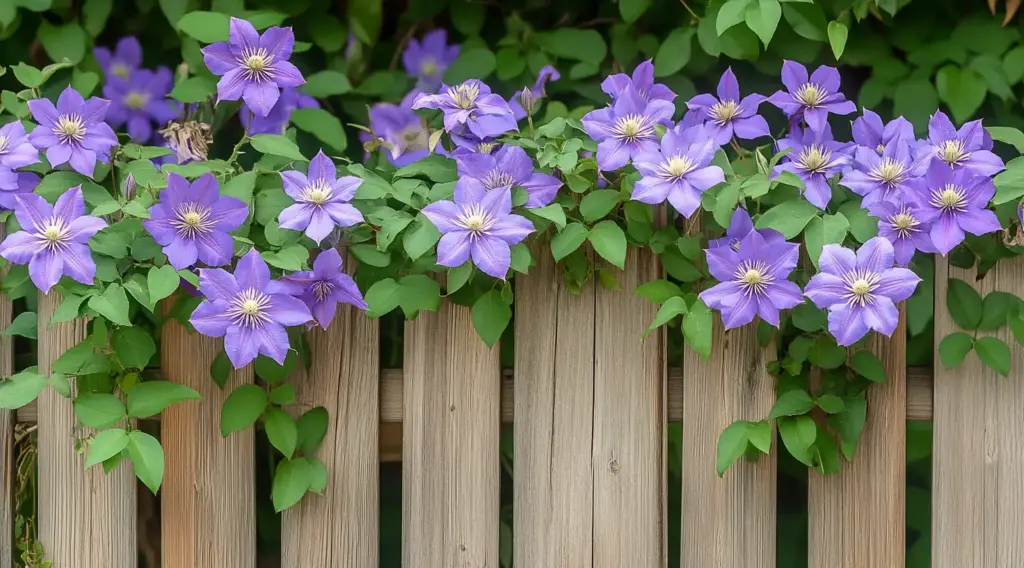
Once your clematis is planted, it’s time to guide those tender vines toward their upward potential. Proper training early on prevents tangles, breakage, and sparse growth later.
🏗 Install Supports Before Planting
We’ve said it before, but it’s worth repeating: always install your trellis, arbor, or other support before planting. This avoids root disruption and allows you to direct growth from day one.
🤲 Be Gentle with the Vines
Clematis may appear lush, but their young stems are extremely fragile. It takes only light pressure to snap them—especially when training them early.
- If a stem breaks, don’t panic. Trim the damaged portion cleanly and let a new shoot take over.
- Always handle stems from the base and avoid bending them around sharp angles.
🪢 Train As They Grow
Keep a close eye on your vine during its first growing season. Direct its growth weekly to help establish a beautiful, even spread across your support structure.
- Loosely tie stems with soft garden twine or stretchy plant tape.
- Wrap stems gently around the structure, guiding them as they climb.
- Check weekly to adjust ties and prevent overcrowding or tangling.
Consistent training early on will reward you with a balanced, well-shaped vine that flowers generously and fills out beautifully over time.
🧾 Conclusion
Growing clematis vines is one of the most rewarding ways to add vertical interest, long-lasting color, and elegant structure to your garden. Whether you’re looking to cover a fence, enhance a trellis, or add a touch of magic to a container garden, clematis vines offer versatility and charm. With the right variety, proper sunlight, thoughtful support, and gentle care, your clematis will reward you with season after season of spectacular blooms. From compact container types to vigorous climbers, there’s a clematis for every space—and every gardener.
❓ Frequently Asked Questions (FAQs)
🗓️ When is the best time to plant clematis vines?
The ideal time for growing clematis vines is in early spring or fall, especially during cooler, overcast mornings. This gives roots time to settle in before facing summer heat or winter chill.
☀️ Do clematis vines need full sun?
Yes, most clematis varieties love full sun (at least 6 hours per day). However, remember the golden rule:
“Head in the sun, feet in the shade.”
Keep the roots cool using mulch or ground covers while ensuring the upper vine basks in the sun.
🌿 How fast do clematis vines grow?
Growth rate depends on the variety.
Fast growers: ‘Jackmanii’, ‘Sweet Autumn Clematis’
Slower growers: Compact or bush-type varieties
Proper planting and support will speed up growth regardless of variety.
🏗 How do I support clematis vines while they grow?
Install a trellis, arbor, fence, or obelisk before planting. Some varieties self-cling with tendrils, while others need loose tying. Always use soft, flexible ties to avoid stem damage.
🪴 Can I grow clematis in containers?
Absolutely! Compact varieties thrive in containers. Choose a deep pot (18″+), fill it with rich potting mix, and provide a mini trellis. Water and feed regularly to keep it blooming.

